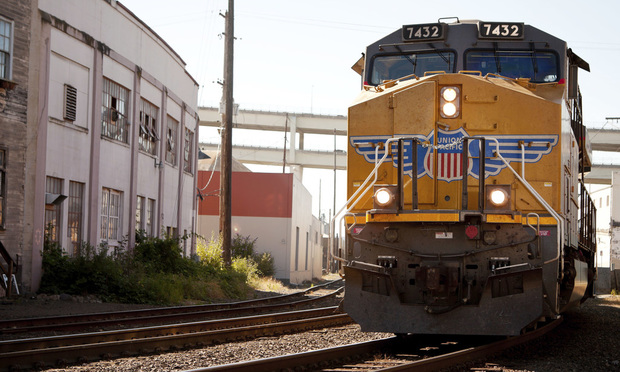Exclusion Did Not Bar Insurance Coverage For Chatsworth Train Collision, California Appellate Court Affirms
A California appellate court found that an “intended or expected” insurance policy exclusion didn't bar coverage for damages in a fatal 2008 head-on collision between a Metrolink commuter train and a Union Pacific freight train in Los Angeles.
April 23, 2018 at 11:49 AM
6 minute read

This story is reprinted with permission from FC&S Legal, the industry's only comprehensive digital resource designed for insurance coverage law professionals. Visit the website to subscribe.
A California appellate court has ruled that an “intended or expected” insurance policy exclusion did not bar insurance coverage for damages resulting from the fatal head-on collision between a Metrolink commuter train and a Union Pacific freight train that occurred in the Chatsworth district of Los Angeles, California, on September 12, 2008.
The Case
After 24 passengers were killed and scores more injured in the Chatsworth collision, the wrongful death and personal injury claims and lawsuits (the “Chatsworth claims”) settled for $200 million, the maximum allowable recovery under federal law for a single rail collision.
The National Transportation Safety Board (“NTSB”) investigated the crash and found that the Metrolink train had run a red light and had begun traveling on a single set of tracks designated for traffic in both directions. According to the NTSB, the Metrolink engineer “was actively, if intermittently, using his wireless device shortly after his train departed Chatsworth station, and his text messaging activity during this time compromised his ability to observe and appropriately respond to the stop signal at Control Point Topanga.” The NTSB also found “[t]he Metrolink engineer was aware that he was violating company safety rules when he used his cell phone to make calls or to send and receive text messages while on duty, but he continued the practice nonetheless.”
The NTSB concluded “the probable cause . . . was the failure of the Metrolink engineer to observe and appropriately respond to the red signal aspect at Control Point Topanga because he was engaged in prohibited use of a wireless device, specifically text messaging, that distracted him from his duties. Contributing to the accident was the lack of a positive train control system that would have stopped the Metrolink train short of the red signal and thus prevented the collision.”
Various insurers interpleaded $146 million for settlement of the Chatsworth claims. In exchange for contributing their aggregate policy limits, the insurers and their insureds – Metrolink, Connex Railroad LLC (which had contracted with Metrolink to operate Metrolink trains in the region), and Connex's parent, Veolia Transportation, Inc. – entered into a “Policy Release and Agreement” under which the insurers retained the right, “if any, to seek contribution and/or subrogation, or to assert policy defenses with respect to Connex [and] Veolia. . . .” Except for the right to assert a setoff in the event the insurers did sue, the insureds “release[d] and forever discharge[d]” the insurers for all liability arising out of the Chatsworth collision.
The insurers then initiated an action against Connex and Veolia based on their policy exclusion for “Bodily Injury, Personal Injury, Property Damage and/or Advertising Injury which the Insured intended or expected or reasonably could have expected.”
For their part, Connex and Veolia maintained that, as a matter of law, the exclusion did not defeat coverage for the Chatsworth accident.
The parties moved for summary judgment.
The trial court found evidence that Metrolink engineers used handheld electronic devices while on duty, in violation of Connex's policies, and that Connex executives knew corporate rules were being violated and accidents could result if engineers were distracted by their cell phones. The trial court, however, granted summary judgment in favor of Connex and Veolia, finding as a matter of law that the policy exclusion did not apply.
The dispute reached the California court of appeal.
The Appellate Court's Decision
The appellate court, interpreting the exclusion under New York law, affirmed the trial court and ruled that the exclusion did not apply as a matter of law.
In its decision, the appellate court noted that there has been no New York decision interpreting the precise language of this exclusion. The appellate court added, however, that New York courts discussing “intended or expected” language in insurance policy exclusions have ruled that coverage was afforded where “accidental results” flowed from “intentional causes” – that is, the appellate court said, where the resulting damage was unintended although the original act or acts leading to the damage were intentional.
In other words, the appellate court added, only where the result was “inherent in the nature of the acts alleged to be committed by the insured” would coverage be denied based on the “expected or intended” exclusion. “[C]atastrophic results which [were] the unintended fruits of willful conduct” still may be covered events, according to the appellate court.
The appellate court was not persuaded by the insurers' contention that the reasonable inference from the evidence that Connex and Veolia knew on-board personnel used cell phones and handheld electronic devices in violation of company policy, did not effectively discipline offending employees, and concealed information concerning these violations from Metrolink was that a reasonable person should have expected the Chatsworth collision.
According to the appellate court, “whether a reasonable person should have expected the Chatsworth collision [was] not the standard.”
Rather, the appellate court said, to defeat summary judgment, the insurers had to present evidence that raised a triable issue of material fact as to whether the Chatsworth collision “flow[ed] directly and immediately from an insured's alleged intentional act.” Because they had not met that burden, the district court had properly granted summary judgment in favor of Connex and Veolia to the effect that the exclusion did not apply.
The case is Certain Underwriters at Lloyd's, London v. Connex Railroad LLC, No. B276373 (Cal Ct.App. April 19, 2018). Attorneys involved include: Vanderford & Ruiz, Ty S. Vanderford, Rodolfo F. Ruiz; and Akin Gump Strauss Hauer & Feld, Rex S. Heinke, Jessica M. Weisel, for Plaintiffs and Appellants. Munger, Tolles & Olsen, Jeremy A. Lawrence, Cary B Lerman, Daniel P. Collins; Farella Braun & Martel, Mary E. McCutcheon, Dennis M. Cusak; Kiesel Law, Paul R. Kiesel, Jeffrey Koncious, Mariana Aroditis; and Weinberg Wheeler Hudgins Gunn & Dial, D. Lee Roberts, Jr., M. Alan Holcomb, for Defendants and Appellants.
Steven A. Meyerowitz, Esq., is the Director of FC&S Legal, the Editor-in-Chief of the Insurance Coverage Law Report, and the Founder and President of Meyerowitz Communications Inc. As FC&S Legal Director, Mr. Meyerowitz, a member of the team that conceptualized FC&S Legal, provides daily analysis and commentary on the most significant insurance coverage law decisions from courts across the country and news regarding legislative and regulatory developments. A graduate of Harvard Law School, Mr. Meyerowitz was an attorney at a prominent Wall Street law firm before founding Meyerowitz Communications Inc., a law firm marketing communications consulting company.
This content has been archived. It is available through our partners, LexisNexis® and Bloomberg Law.
To view this content, please continue to their sites.
Not a Lexis Subscriber?
Subscribe Now
Not a Bloomberg Law Subscriber?
Subscribe Now
NOT FOR REPRINT
© 2025 ALM Global, LLC, All Rights Reserved. Request academic re-use from www.copyright.com. All other uses, submit a request to [email protected]. For more information visit Asset & Logo Licensing.
You Might Like
View All
US Patent Innovators Can Look to International Trade Commission Enforcement for Protection, IP Lawyers Say

Attorney of the Year Finalist: Michael Rubin, Latham & Watkins

John Hueston Appointed Monitor by CA Court Judge in Ruling on Veterans' Housing Case

Ex-Federal Prosecutor and White-Collar Defense Lawyer Joins Foundation Law Group
Trending Stories
- 1Uber Files RICO Suit Against Plaintiff-Side Firms Alleging Fraudulent Injury Claims
- 2The Law Firm Disrupted: Scrutinizing the Elephant More Than the Mouse
- 3Inherent Diminished Value Damages Unavailable to 3rd-Party Claimants, Court Says
- 4Pa. Defense Firm Sued by Client Over Ex-Eagles Player's $43.5M Med Mal Win
- 5Losses Mount at Morris Manning, but Departing Ex-Chair Stays Bullish About His Old Firm's Future
Who Got The Work
J. Brugh Lower of Gibbons has entered an appearance for industrial equipment supplier Devco Corporation in a pending trademark infringement lawsuit. The suit, accusing the defendant of selling knock-off Graco products, was filed Dec. 18 in New Jersey District Court by Rivkin Radler on behalf of Graco Inc. and Graco Minnesota. The case, assigned to U.S. District Judge Zahid N. Quraishi, is 3:24-cv-11294, Graco Inc. et al v. Devco Corporation.
Who Got The Work
Rebecca Maller-Stein and Kent A. Yalowitz of Arnold & Porter Kaye Scholer have entered their appearances for Hanaco Venture Capital and its executives, Lior Prosor and David Frankel, in a pending securities lawsuit. The action, filed on Dec. 24 in New York Southern District Court by Zell, Aron & Co. on behalf of Goldeneye Advisors, accuses the defendants of negligently and fraudulently managing the plaintiff's $1 million investment. The case, assigned to U.S. District Judge Vernon S. Broderick, is 1:24-cv-09918, Goldeneye Advisors, LLC v. Hanaco Venture Capital, Ltd. et al.
Who Got The Work
Attorneys from A&O Shearman has stepped in as defense counsel for Toronto-Dominion Bank and other defendants in a pending securities class action. The suit, filed Dec. 11 in New York Southern District Court by Bleichmar Fonti & Auld, accuses the defendants of concealing the bank's 'pervasive' deficiencies in regards to its compliance with the Bank Secrecy Act and the quality of its anti-money laundering controls. The case, assigned to U.S. District Judge Arun Subramanian, is 1:24-cv-09445, Gonzalez v. The Toronto-Dominion Bank et al.
Who Got The Work
Crown Castle International, a Pennsylvania company providing shared communications infrastructure, has turned to Luke D. Wolf of Gordon Rees Scully Mansukhani to fend off a pending breach-of-contract lawsuit. The court action, filed Nov. 25 in Michigan Eastern District Court by Hooper Hathaway PC on behalf of The Town Residences LLC, accuses Crown Castle of failing to transfer approximately $30,000 in utility payments from T-Mobile in breach of a roof-top lease and assignment agreement. The case, assigned to U.S. District Judge Susan K. Declercq, is 2:24-cv-13131, The Town Residences LLC v. T-Mobile US, Inc. et al.
Who Got The Work
Wilfred P. Coronato and Daniel M. Schwartz of McCarter & English have stepped in as defense counsel to Electrolux Home Products Inc. in a pending product liability lawsuit. The court action, filed Nov. 26 in New York Eastern District Court by Poulos Lopiccolo PC and Nagel Rice LLP on behalf of David Stern, alleges that the defendant's refrigerators’ drawers and shelving repeatedly break and fall apart within months after purchase. The case, assigned to U.S. District Judge Joan M. Azrack, is 2:24-cv-08204, Stern v. Electrolux Home Products, Inc.
Featured Firms
Law Offices of Gary Martin Hays & Associates, P.C.
(470) 294-1674
Law Offices of Mark E. Salomone
(857) 444-6468
Smith & Hassler
(713) 739-1250






